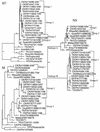Phylogenetic analysis of H7 avian influenza viruses isolated from the live bird markets of the Northeast United States
- PMID: 10196246
- PMCID: PMC104129
- DOI: 10.1128/JVI.73.5.3567-3573.1999
Phylogenetic analysis of H7 avian influenza viruses isolated from the live bird markets of the Northeast United States
Abstract
The presence of low-pathogenic H7 avian influenza virus (AIV), which is associated with live-bird markets (LBM) in the Northeast United States, was first detected in 1994 and, despite efforts to eradicate the virus, surveillance of these markets has resulted in numerous isolations of H7 AIVs from several states from 1994 through 1998. The hemagglutinin, nonstructural, and matrix genes from representative H7 isolates from the LBM and elsewhere were sequenced, and the sequences were compared phylogenetically. The hemagglutinin gene of most LBM isolates examined appeared to have been the result of a single introduction of the hemagglutinin gene. Evidence for evolutionary changes were observed with three definable steps. The first isolate from 1994 had the amino acid threonine at the -2 position of the hemagglutinin cleavage site, which is the most commonly observed amino acid at this site for North American H7 AIVs. In January 1995 a new genotype with a proline at the -2 position was detected, and this genotype eventually became the predominant virus isolate. A third viral genotype, detected in November 1996, had an eight-amino-acid deletion within the putative receptor binding site. This viral genotype appeared to be the predominant isolate, although isolates with proline at the -2 position without the deletion were still observed in viruses from the last sampling date. Evidence for reassortment of multiple viral genes was evident. The combination of possible adaptive evolution of the virus and reassortment with different influenza virus genes makes it difficult to determine the risk of pathogenesis of this group of H7 AIVs.
Figures



References
-
- Banks J, Speidel E, Alexander D J. Characterization of an avian influenza A virus isolated from a human—is an intermediate host necessary for the emergence of pandemic influenza viruses? Arch Virol. 1998;143:781–787. - PubMed
-
- Beare A S, Webster R G. Replication of avian influenza viruses in humans. Arch Virol. 1991;119:37–42. - PubMed
-
- Bosch F X, Garten W, Klenk H D, Rott R. Proteolytic cleavage of influenza virus hemagglutinins: primary structure of the connecting peptide between HA1 and HA2 determines proteolytic cleavability and pathogenicity of avian influenza viruses. Virology. 1981;113:725–735. - PubMed
-
- Daly J M, Lai A C, Binns M M, Chambers T M, Barrandeguy M, Mumford J A. Antigenic and genetic evolution of equine H3N8 influenza A viruses. J Gen Virol. 1996;77:661–671. - PubMed
-
- Davidson W R, Yoder H W, Brugh M, Nettles V F. Serological monitoring of Eastern Wild Turkeys for antibodies to Mycoplasma spp. and avian influenza viruses. J Wildl Dis. 1988;24:348–351. - PubMed
Publication types
MeSH terms
Substances
Associated data
- Actions
- Actions
- Actions
- Actions
- Actions
- Actions
- Actions
- Actions
- Actions
- Actions
- Actions
- Actions
- Actions
- Actions
- Actions
- Actions
- Actions
- Actions
- Actions
- Actions
- Actions
- Actions
- Actions
- Actions
- Actions
- Actions
- Actions
- Actions
- Actions
- Actions
LinkOut - more resources
Full Text Sources
Other Literature Sources
Medical

